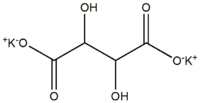- Potassium tartrate
-
Potassium tartrate  Dipotassium 2,3-dihydroxybutanedioateOther namesDipotassium tartrate; Argol; E336
Dipotassium 2,3-dihydroxybutanedioateOther namesDipotassium tartrate; Argol; E336Identifiers CAS number 921-53-9, (L) PubChem 6100505 ChemSpider 2697916 
Jmol-3D images Image 1 - [K+].[K+].O=C([O-])C(O)C(O)C([O-])=O
Properties Molecular formula C4H4K2O6 Molar mass 226.27 g/mol  tartrate (verify) (what is:
tartrate (verify) (what is:  /
/ ?)
?)
Except where noted otherwise, data are given for materials in their standard state (at 25 °C, 100 kPa)Infobox references Potassium tartrate, dipotassium tartrate or argol has formula K2C4H4O6. It is the potassium salt of tartaric acid. It is often confused with potassium bitartrate, also known as cream of tartar. As a food additive, it shares the E number E336 with potassium bitartrate.
Other compounds
Tartar emetic is produced when potassium tartrate is heated with antimony trioxide. Tartar emetic causes intense nausea, prostration and vomiting by irritating the gastrointestinal mucosa.[citation needed] Potassium sodium tartrate (Rochelle salt) is produced by heating together solutions of potassium hydrogen tartrate and sodium carbonate.
Categories:- Potassium compounds
- Tartrates
- Food acidity regulators
- Food antioxidants
Wikimedia Foundation. 2010.
